-
Recent Posts
Categories
Latest Tweets
Tag Cloud
advertising american express amex blog blogging brand branding budget friendly business cards business success commercial printing commerical printing company brand direct mail effective marketing email email marketing facebook globaltech globaltech east inc google graphic design keywords logo mail marketing online online marketing online reputation pay-per-click ads print printing print marketing print myths print rumors reputation sbs seo small business small business saturday social social media twitter website website content
Author Archives: globaltechnj
GlobalTech East Inc. lends its support to Small Business Saturday®
 Toms River – November 25, 2015 – GlobalTech East Inc. today announced its participation in this year’s Small Business Saturday, taking place on November 28th. Small Business Saturday is a day dedicated to strengthening the community by supporting local small businesses.
Toms River – November 25, 2015 – GlobalTech East Inc. today announced its participation in this year’s Small Business Saturday, taking place on November 28th. Small Business Saturday is a day dedicated to strengthening the community by supporting local small businesses.
GlobalTech East Inc. will be offering a Free Website with the purchase of any Maintenance Plan to any customer who shops with us between November 28, 2015 to December 4, 2015.
Created by American Express in 2010, Small Business Saturday serves as the ceremonial kickoff to the holiday shopping season for small businesses across the United States. In 2014, nearly 3,000 Neighborhood Champions rallied local businesses and created events and activities to drive shopping at small businesses around the country. The day was also championed by elected officials in all 50 states and Washington, D.C., including President Obama.
GlobalTech East Inc. recognizes the importance of supporting small businesses in
Toms River, the jobs they help create, and the culture they instill in local communities. According to the U.S. Small Businesses Administration, as of 2014, small businesses nationwide accounted for 63% of net new private-sector jobs created and represented 99.7% of all employer firms.¹
Merchants and consumers can learn more about Small Business Saturday and how to get involved by visiting ShopSmall.com and the official Small Business Saturday Facebook page.
Contacts:
Frank Vitolo
GlobalTech East Inc.
732.929.92498
fvitolo@globaltechnj.com
ABOUT SMALL BUSINESS SATURDAY
November 28th marks the sixth annual Small Business Saturday, a day to support the local businesses that create jobs, boost the economy and preserve neighborhoods around the country. Small Business Saturday was created in 2010 in response to small business owners’ most pressing need: more customers.
¹Small Business Administration Office of Advocacy Frequently Asked Questions, March 2014.
Posted in GlobalTech News
Tagged american express, amex, globaltech, globaltech east inc, november 28, sbs, small business, small business saturday
What the Color of Your Logo Says About Your Company
If you are building a company that depends on making people feel sexy and sophisticated, it’s probably going to confuse your consumers if you your logo is bright green.
That’s because different colors are associated with different feelings. Green conveys organic growth, the earth, nature, or feelings of caring. Meanwhile, black communicates feelings of sophistication, authority or seduction. Not convinced? Consider the green logo for Starbucks or Greenpeace and the black logos of Chanel or Sony.
Color isn’t the only design element that communicates with your customer about your brand. Font, spacing between letters and shape also tell your brand story in that instant when a first impression is formed.
Have a look at the infographic below, compiled by Canadian plastic-card maker Colourfast, to get a sense of whether your logo is conveying the right message.
Posted in Marketing Strategy
Tagged advertising, brand, branding, design, graphic design, logo, logo design, marketing
How to Create a Marketing Plan
Firms that are successful in marketing invariably start with a marketing plan. Large companies have plans with hundreds of pages; small companies can get by with a half-dozen sheets. Put your marketing plan in a three-ring binder. Refer to it at least quarterly, but better yet monthly. Leave a tab for putting in monthly reports on sales/manufacturing; this will allow you to track performance as you follow the plan.
The plan should cover one year. For small companies, this is often the best way to think about marketing. Things change, people leave, markets evolve, customers come and go. Later on we suggest creating a section of your plan that addresses the medium-term future–two to four years down the road. But the bulk of your plan should focus on the coming year.
You should allow yourself a couple of months to write the plan, even if it’s only a few pages long. Developing the plan is the “heavy lifting” of marketing. While executing the plan has its challenges, deciding what to do and how to do it is marketing’s greatest challenge. Most marketing plans kick off with the first of the year or with the opening of your fiscal year if it’s different.
Who should see your plan? All the players in the company. Firms typically keep their marketing plans very, very private for one of two very different reasons: Either they’re too skimpy and management would be embarrassed to have them see the light of day, or they’re solid and packed with information . . . which would make them extremely valuable to the competition.
You can’t do a marketing plan without getting many people involved. No matter what your size, get feedback from all parts of your company: finance, manufacturing, personnel, supply and so on–in addition to marketing itself. This is especially important because it will take all aspects of your company to make your marketing plan work. Your key people can provide realistic input on what’s achievable and how your goals can be reached, and they can share any insights they have on any potential, as-yet-unrealized marketing opportunities, adding another dimension to your plan. If you’re essentially a one-person management operation, you’ll have to wear all your hats at one time–but at least the meetings will be short!
What’s the relationship between your marketing plan and your business plan or vision statement? Your business plan spells out what your business is about–what you do and don’t do, and what your ultimate goals are. It encompasses more than marketing; it can include discussions of locations, staffing, financing, strategic alliances and so on. It includes “the vision thing,” the resounding words that spell out the glorious purpose of your company in stirring language. Your business plan is the U.S. Constitution of your business: If you want to do something that’s outside the business plan, you need to either change your mind or change the plan. Your company’s business plan provides the environment in which your marketing plan must flourish. The two documents must be consistent.
The Benefits of a Marketing Plan
A marketing plan, on the other hand, is plump with meaning. It provides you with several major benefits. Let’s review them.
- Rallying point: Your marketing plan gives your troops something to rally behind. You want them to feel confident that the captain of the vessel has the charts in order, knows how to run the ship, and has a port of destination in mind. Companies often undervalue the impact of a “marketing plan” on their own people, who want to feel part of a team engaged in an exciting and complicated joint endeavor. If you want your employees to feel committed to your company, it’s important to share with them your vision of where the company is headed in the years to come. People don’t always understand financial projections, but they can get excited about a well-written and well-thought-out marketing plan. You should consider releasing your marketing plan–perhaps in an abridged version–companywide. Do it with some fanfare and generate some excitement for the adventures to come. Your workers will appreciate being involved.
- Chart to success: We all know that plans are imperfect things. How can you possibly know what’s going to happen 12 months or five years from now? Isn’t putting together a marketing plan an exercise in futility . . . a waste of time better spent meeting with customers or fine-tuning production? Yes, possibly but only in the narrowest sense. If you don’t plan, you’re doomed, and an inaccurate plan is far better than no plan at all. To stay with our sea captain analogy, it’s better to be 5 or even 10 degrees off your destination port than to have no destination in mind at all. The point of sailing, after all, is to get somewhere, and without a marketing plan, you’ll wander the seas aimlessly, sometimes finding dry land but more often than not floundering in a vast ocean. Sea captains without a chart are rarely remembered for discovering anything but the ocean floor.
- Company operational instructions: Your child’s first bike and your new VCR came with a set of instructions, and your company is far more complicated to put together and run than either of them. Your marketing plan is a step-by-step guide for your company’s success. It’s more important than a vision statement. To put together a genuine marketing plan, you have to assess your company from top to bottom and make sure all the pieces are working together in the best way. What do you want to do with this enterprise you call the company in the coming year? Consider it a to-do list on a grand scale. It assigns specific tasks for the year.
- Captured thinking: You don’t allow your financial people to keep their numbers in their heads. Financial reports are the lifeblood of the numbers side of any business, no matter what size. It should be no different with marketing. Your written document lays out your game plan. If people leave, if new people arrive, if memories falter, if events bring pressure to alter the givens, the information in the written marketing plan stays intact to remind you of what you’d agreed on.
- Top-level reflection: In the daily hurly-burly of competitive business, it’s hard to turn your attention to the big picture, especially those parts that aren’t directly related to the daily operations. You need to take time periodically to really think about your business–whether it’s providing you and your employees with what you want, whether there aren’t some innovative wrinkles you can add, whether you’re getting all you can out of your products, your sales staff and your markets. Writing your marketing plan is the best time to do this high-level thinking. Some companies send their top marketing people away to a retreat. Others go to the home of a principal. Some do marketing plan development at a local motel, away from phones and fax machines, so they can devote themselves solely to thinking hard and drawing the most accurate sketches they can of the immediate future of the business.
Ideally, after writing marketing plans for a few years, you can sit back and review a series of them, year after year, and check the progress of your company. Of course, sometimes this is hard to make time for (there is that annoying real world to deal with), but it can provide an unparalleled objective view of what you’ve been doing with your business life over a number of years.
Posted in Marketing Strategy
Tagged advertising, advertising budget, advertising plan, business plan, marketing, marketing budget, marketing plan
GlobalTech East Inc. lends its support to Small Business Saturday®
 Toms River– November 25, 2014 – GlobalTech East Inc. today announced its participation in this year’s Small Business Saturday, taking place on November 29, 2014. Small Business Saturday is a day dedicated to strengthening the community by supporting local small businesses.
Toms River– November 25, 2014 – GlobalTech East Inc. today announced its participation in this year’s Small Business Saturday, taking place on November 29, 2014. Small Business Saturday is a day dedicated to strengthening the community by supporting local small businesses.
GlobalTech East Inc. will be offering 250 Free Business cards to any customer who shops with us between November 29, 2014 to December 5, 2014.
Now in its fifth year, Small Business Saturday serves as the ceremonial kickoff to the holiday shopping season for small businesses across the United States. In 2013, nearly 1,500 Neighborhood Champions rallied local businesses and created events and activities to drive shopping at small businesses around the country. The day was also championed by elected officials in all 50 states and Washington D.C., including President Obama who took his daughters shopping at a local bookstore.
GlobalTech East Inc. recognizes the importance of supporting small business in Toms River, the jobs they help create and the culture they instill in local communities. According to the U.S. Small Businesses Administration, as of 2012, small businesses nationwide accounted for 64% of net new private-sector jobs created and represented 99.7% of all employer firms.1
Merchants and consumers can learn more about Small Business Saturday and how to get involved by visiting ShopSmall.com and the official Small Business Saturday Facebook page.
Contacts:
Frank Vitolo
GlobalTech East Inc.
732.929.2498
fvitolo@globaltechnj.com
ABOUT SMALL BUSINESS SATURDAY
Nov 29 marks the fifth annual Small Business Saturday, a day to support the local businesses that create jobs, boost the economy and preserve neighborhoods around the country. Small Business Saturday was created in 2010 in response to small business owners’ most pressing need: more customers. To date, more than 3.3 million Facebook users “liked” the Small Business Saturday page2. Just last year, 370+ advocacy organizations, 160+ corporations, and elected officials in all 50 states and Washington D.C. declared their support for Small Business Saturday.
1 Small Business Administration Office of Advocacy Frequently Asked Questions, September 2012
2 According to Facebook Insights, the Small Business Saturday page on Facebook at https://www.facebook.com/#!/SmallBusinessSaturday received 3,316,569 “Likes” as of 5/20/2014
Posted in GlobalTech News
Tagged american express, amex, globaltech, globaltech east inc, november 29, sbs, small business, small business saturday
How Much Does a Website Cost?
By: Chris Foss, Published August 31, 2014
Over the past 18 years, I have written thousands of website proposals – for design, development, hosting, and/or marketing (SEO) – for companies and organizations of every size and (just about) every industry. Some people want a basic brochure website, others might want full online marketing strategies, while others ask for things that are, literally, impossible to develop. Everyone, however, always wants to know:
“How much will this website cost?”
And after 18 years, my answer is still the same. Websites can cost anywhere from free to more than $100 million, it all depends on what you want to actually achieve online.
Let’s discuss the design and build first
To start, ask yourself a few questions.
1. Are you looking to sell products online or include any ecommerce?
2. Do you require backend integration with any internal databases or systems (CRM, AMS, Inventory/warehouse system, accounting)?
3. Is your website primarily a marketing and informational site?
4. How tech savvy is your staff?
5. How established is your brand (i.e. will your web design be creating everything from scratch or do you have established brand guidelines)?
Finally, one of the toughest questions of all: how valuable is this website to your business or organization? If your business is a local Burger King franchise, then a website, while important, is not overly valuable compared to the rest of your marketing and operational needs. However, if your business is an online dating service, where the website IS the business, then obviously the design and build of the website will require much more attention and ongoing development.
Ok, so how much should I budget for my website?
Now that you’ve asked yourself some important questions, let’s get down to at least some budget ranges.
Cost of Basic Websites
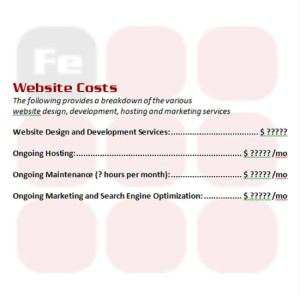 For many small businesses, a basic website is a great place to start. These types of websites can range from FREE (but be careful what you sign up for!) to around $5,000. A basic website is typically 3-10 pages and really just focuses on providing basic information about the business – who you are, what you offer, and how to contact you. A website company will typically stylize an existing theme or template and work with clients to build out these sites for $4,000-$5,000.
For many small businesses, a basic website is a great place to start. These types of websites can range from FREE (but be careful what you sign up for!) to around $5,000. A basic website is typically 3-10 pages and really just focuses on providing basic information about the business – who you are, what you offer, and how to contact you. A website company will typically stylize an existing theme or template and work with clients to build out these sites for $4,000-$5,000.
Cost of Custom Websites
I truly believe that all businesses should eventually have a custom or advanced website. Basic, template websites are fantastic for businesses starting out with a limited budget, but for a website to truly work for you and generate an ROI, you should consider a Web firm to build you a custom design website. After all, look at any successful website that you visit on a regular basis. Are any of them templates? No. And there is a good reason for that.
A firm will work with you to build a custom design website, and the process should start with in-depth discussions about your target audiences, corporate culture, online business goals, and behavior/conversion goals. A custom site should be developed to successfully address all of these points in order to establish a strong, effective website for your business or organization. Custom website designs typically fall anywhere from $9,000 – $20,000; however, depending on the size and requirements of your website, the cost can certainly fall above this range.
Cost of Advanced Websites
Advanced websites are really any project that goes beyond a marketing/informational website. These are websites that include ecommerce, highly interactive features, backend integration, and custom programming. Projects like these are spec’d out on a case-by-case basis and can cost anywhere from $20,000 to several million dollars.
Marketing Costs
As you can imagine, marketing costs can also vary greatly simply because there are a wide range of marketing services that we can apply to any website. Typical engagements with a firm include SEO services, social media campaigns, email marketing efforts, and consulting with online advertising. Marketing costs are usually centered around ongoing efforts and measurable marketing goals that we establish directly with you. Based on these efforts and deliverables, marketing costs typically range from $500/mo to $5,000/mo, again, depending on how involved, and how aggressive, you want your web firm to be.
Additional Costs
As you finalize your budget, keep in mind some of these additional costs as well.
1. Purchasing a domain name ($10-$20/year)
2. Hosting (usually $20-$100/mo depending on hosting needs)
3. Ongoing Maintenance – Don’t forget about this one. Despite how perfect the website might be at launch, within a few months, you can already start making upgrades. Platforms and plugins need upgraded and new functionality/new designs can always improve your site. You should plan to evolve your website on a regular basis, and this is usually provided on either an “as needed” basis or through a maintenance retainer.
4. Security Certificate for forms with private information or ecommerce ($200/yr)
5. Stock Photography ($20-$100 per image) or Professional Photography if needed
6. Video production if needed
Read more at https://www.business2community.com/online-marketing/much-website-cost-0987537#SdyRbhIFQFhkk4Vk.99
Posted in Online Marketing
Tagged advertising, marketing, online marketing, seo, website, website cost, website design, website develop
8 Ways to Make Your Marketing Message Stand Out

In Market Like You Mean It, marketing expert Al Lautenslager explains how you can engage your customers, create brand believers and gain fans for everything you sell. In this edited excerpt, the author describes eight strategies you can use to make your marketing messages cut through the media clutter that your prospects and customers see every day.
How does a marketer stand out in the crowded marketing storm? How can you hit your target market right between the eyes and cut through the media clutter that’s all around you? Answering these questions represents the holy grail of marketing.
Every day there are new messaging ideas and repurposed content from thought leaders and marketers of all types. If your messages are part of that clutter, your goal is to lift them above the clutter and get noticed. Here are eight essentials to consider as you start off and move closer to that marketing holy grail:
1. Focus on solutions. This is what customers are really looking for. And when there’s demand, half of your marketing job is done. Products and services that have a high demand get noticed early and often. Give your target market what they want or what they’re interested in looking at. Offer something that shouts “I’m a problem solver” or “I’m a solution” quickly, and your message will get noticed.
2. Aim at your target market. Marketing that doesn’t hit its intended target is classified as a waste, inefficient or junk (as in “junk mail”). Marketing that does hit its target market is classified as interesting, effective and very efficient. The key here is to give your target market something that interests them. If you’re a senior citizen interested in classical music, a direct-mail piece about the newest music releases for the latest rock-and-roll bands won’t do the job — you’re not part of the rock-and-roll music target market.
3. Use headlines and subtitles. Make these titles (and subtitles) provocative, thought-provoking, extreme and completely unexpected. One of the best headlines I’ve seen–one I know got noticed–was “Things the Government Won’t Tell You About Terrorism.” Another one that garnered equal attention was “7 Mistakes Banks Make Every Day.” Both would get attention and make people want to read more.
4. Have a crystal-clear message. Graphics can get attention, but don’t let them overwhelm your marketing to the point where your message isn’t being communicated. The famous advertising guru David Ogilvy once said, “I do not regard advertising as an entertainment or an art form but as a medium of information. When I write an advertisement, I don’t want you to tell me that you find it creative. I want you to find it so interesting that you buy the product.” You can’t bore people into taking notice with boring or unclear messages.
5. Try extreme marketing messaging. The truth is, extreme marketing works. Things that state the opposite, the negative and mistakes get attention. Here are examples of headlines or messages that get noticed because of their extreme nature:
•How to Run Your Company into the Ground in One Week
•How to Make Your Salespeople 10 Percent More Efficient
•How I Grew Profits by 0.005 Percent
All these headlines would probably get your attention and make you want to read on because of their extreme nature.
6. Offer a marketing hook. This is another way to get noticed that’s especially prevalent in content marketing circles today. Simply put, information is offered as an incentive for additional contact. This “hooks” a prospect, setting the stage for further communication. Here are a few examples of hooks:
•Call us today for a free mortgage loan calculator.
•Download a free recipe ebook that uses our spices and seasonings.
•Stop by today for a free vase for your Mother’s Day flowers.
All these hooks offer something of value to an interested prospect. They’ll all increase not only the attention your pieces get but your response rates as well.
7. Leverage odd items, shapes, and sizes. Another thing to consider when you want your pieces to stand out from the crowd is to create something that’s a different size or has a different tone or is otherwise outside the normal format. This includes odd-shaped mailing pieces, extreme colors or messages, and choosing unusual times at which to approach your target market, like talking about Christmas in the spring. Carlsbad Brewery once dropped fake passports in the New York City subway system to notify their target market about a new product they were launching. Finding a passport on the subway was unexpected; it’s not something you see every day. Carlsbad’s messages got noticed.
8. Answer directly “What’s in it for the prospect?” Holiday Inn Express advertised that their motels had the “number-one customer-rated showerhead.” Have you ever been asked to rate a showerhead? Holiday Inn discovered this was important to their target market and communicated that message directly to them. You can listen and read all about the features of a Holiday Inn Express, but hearing about the number-one customer-rated showerhead speaks to something all visitors want. What’s in it for them? A superior shower. Superior showers get noticed.
Standing out from the marketing clutter will always be a marketer’s challenge. Starting with these fundamentals will help you break through.
Posted in Marketing Strategy
Tagged advertising, marketing, online marketing, print marketing, social media marketing
67% Of Americans Use Social Media (With One In Six Active On Twitter)
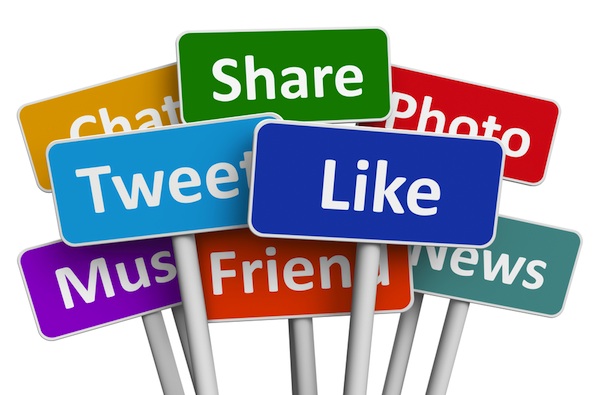 Two thirds of Americans have a profile on one or more social networks, reveals a new study, with about one in six (16 percent) using Twitter.
Two thirds of Americans have a profile on one or more social networks, reveals a new study, with about one in six (16 percent) using Twitter.
Edison Research surveyed more than two thousand U.S. citizens re using digital platforms and found that 67 percent of respondents use social media.
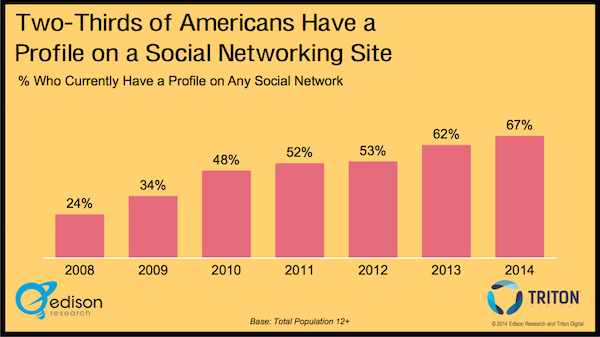 Of these, more than half (58 percent) are active on Facebook – a statistic that is unchanged year-on-year – with 19 percent using LinkedIn (up two percentage points), 19 percent on Instagram (up 7 percentage points), 17 percent on Google+ (up 5 percentage points) and 16 percent on Twitter (up 1 percentage point).
Of these, more than half (58 percent) are active on Facebook – a statistic that is unchanged year-on-year – with 19 percent using LinkedIn (up two percentage points), 19 percent on Instagram (up 7 percentage points), 17 percent on Google+ (up 5 percentage points) and 16 percent on Twitter (up 1 percentage point).
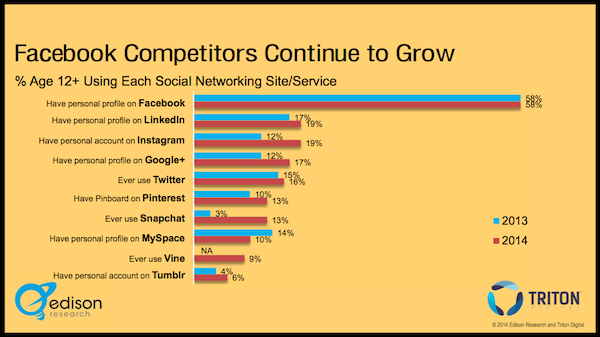
As you might expect, all social networks – with the exception of LinkedIn – are more popular amongst the younger demographic.
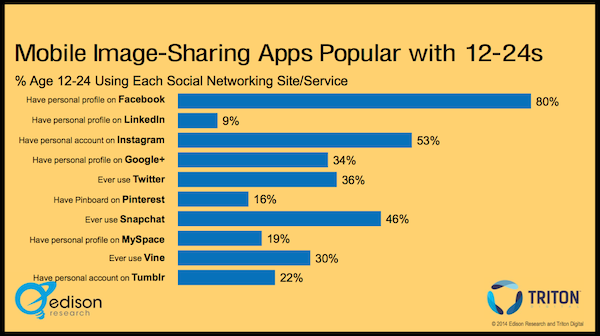
An estimated 75 million Americans check their social networks several times each day.
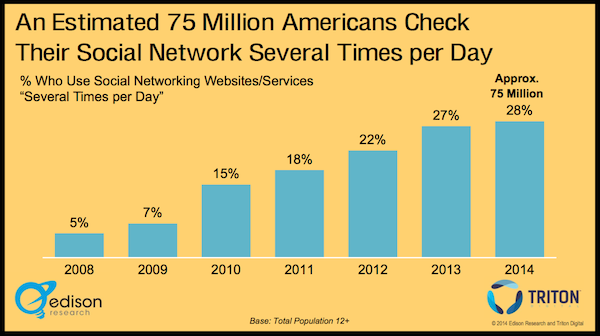
Overall, these numbers are bullish for social media but not particularly strong for Twitter, which increasingly looks like it will have to keep a very close eye on Instagram (and even Snapchat) for attention from users of all ages, but especially the next generation of consumers.
Posted in Online Marketing
Tagged facebook, online marketing, social media, social networks, twitter
3 Things You Probably Don’t Know About Google Adwords
I get asked all the time about Google Adwords. For the uninitiated, Adwords are the ads on the top and side of Google when you enter in a search. Entrepreneurs are always wanting to rank their website at the top of every search, but there are certain things that you need to know before getting started with Adwords.
So I decided to answer three of the questions I get asked the most — all in one article. This won’t answer every question you may have but this should be a good start.
1. There are three types of keywords.
In the online world, there are three types of keywords that consumers use when searching online that business owners need to keep in mind. First they do their research, then they compare products and then they search with the intent to purchase. For instance, this is the exact process I used to purchase my new Bluetooth wireless headset:
Research phrases: When someone is in the research phase, the person often has no idea what he or she wants, searching only for generic and simple terms. I started my search with “headsets.” During this process, I learned that there are all kinds of different headsets: wireless, non-wireless, microphone, no microphone, etc. Notice, I have no idea what brand I want yet.
Comparison: As I peruse the search results for those generic terms, things start to get more specific. Not only am I reading reviews, but I’m pitting two products against each other. If you were in the comparison stage, you would most likely use terms like:
•Beats vs Bose
•Beats by Dre review
•Beats pricing
•Beats alternative
I personally don’t recommend that business owners purchase these types of phrases as I think they are a waste of your money. These types of phrases are used by people who are searching for an answer and are merely investigating a future purchase. If you’re bidding on phrases like this, try stopping for a week and see if your profits rise.
Buyer: A customer often has his or her credit card sitting next to the keyboard as they are searching. That’s why you need to come up with the right keywords that they are searching for. Most people know exactly what they want, just not where to find it. So they search. They will use specific keywords. You can always tell you have a “buyer keyword” when they use the following:
•color
•size
•make
•model
•brand name
For example, as I read reviews of headsets, I finally found the one I wanted. It was made by Planatronics and called the Audio 995. I was ready to purchase and I entered into the Google search results the phrase “Planatronics Audio 995.”
This is what I call buyer keywords. These are keyword phrases that people use with specific things about the product. If you know these keywords, you should be bidding on them as they usually lead to sales.
2. Try dynamic keyword insertion.
You can save time when you use dynamic keyword insertion. Rather than writing lots of ads, you can shortcut the process by putting {keyword} in the ad. It can be used in a number of different places:
•The headline
•The description lines
•Display URL
•Destination URL
Let’s say you have 1,000 keywords and you don’t want to write 1,000 different ads. All you have to do is add {keyword} and your desired keywords will appear. In most cases the keyword or keyword phrase the searcher just used while searching in Google.
In case you have a keyword that won’t fit in the ad, you can set a default word. If your default word was banana, then you do the following: {keyword:banana}. There isn’t a space between the colon and banana.
3. Ad position doesn’t affect CTR.
Because I’m going to get a lot of slack for saying this, I want to make sure that you read this carefully. The range of ad position for the first page of Google is 1 to 11. I’ve found that click-through-rate (CTR) isn’t affected by the ad position. Note that it doesn’t affect quality score either.
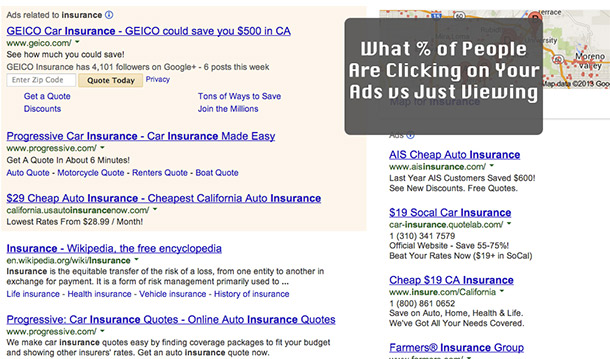
How can I make such a claim? Google bolds the keyword that is being searched for by a user. As you can see in the search above, I searched for “Insurance” and it’s bolded in the picture.
User sees your ad and sees that it’s relevant to them. The CTR will be the same, regardless of ad position. Make sure your keywords are in the ad somewhere, preferably the Title.
Posted in Online Marketing
Tagged adwords, cpc, google, google adwords, keywords, online ads, online marketing, ppc
Want Customers to Open Your Emails? Read This.
In a rush to acquire customers through Twitter and Facebook, email marketing is often dismissed as outdated and out fashioned. Why craft an email when you can engage on social media?
But don’t dismiss the ancient act of sending emails so quickly; Tweeting and “liking” may be flashier, but a recent McKinsey & Co. survey states that email is vastly more effective way to acquire customers. How much more effective? Nearly 40 times more than Facebook and Twitter combined.
All marketing emails, of course, aren’t created equal. It’s all in the subject line – whether or not a customer decides to open your email or trash it rests entirely on its clickability. Luckily, a new study uncovers the attributes needed to create an effective subject line. Retention Science analyzed 267 million emails sent across 543 campaigns over the past six months. If you want to reach customers through email, consider these tips when crafting your next subject line.
Keep it between six to 10 words. Subject lines with six to 10 words perform best, generating a 21 percent open rate, well above industry standard. Those with subject lines containing five or fewer words ranked second with a 16 percent open rate, and those with 11–15 words returned a minimal 14 percent open rate. Despite this, the majority of emails sent (52 percent) had subject lines in the 11-15 word range.
Consider the device it will be read on. Thirty-five percent of emails are opened on mobile devices. Given that most smart phones only display five or six words of a subject line, being brief and concise is even more critical for mobile marketing.
Take a personalized approach. It’s shown to help re-engage and retain customers. Of the email campaigns studied, those with the recipient’s first name in the subject line delivered a 2.6 percent increase in open rates compared to those without a name.
Consider referencing a movie or a song. A separate Retention Science study analyzed 3.7 million emails and 22 campaigns where movie names or song lyrics were referenced in the subject line and found they were opened 26 percent of the time, while emails with more traditional subject lines were opened 16 percent of the time. Again, this allows you to take a more personal approach, and target certain customer segments.
Reconsider flash sale campaign. Nearly 80 percent of flash-sale email campaigns had subject lines in excess of 20 words; unsurprisingly, they consistently underperformed compared to campaigns with shorter subject lines. Their bad performance record may also be blamed on the frequency at which they’re sent — flash sale brands tend to email customers four to eight times a week compared to the industry standard of two to four times a week.
Posted in Online Marketing
Tagged email, email campaign, email marketing, marketing, online marketing

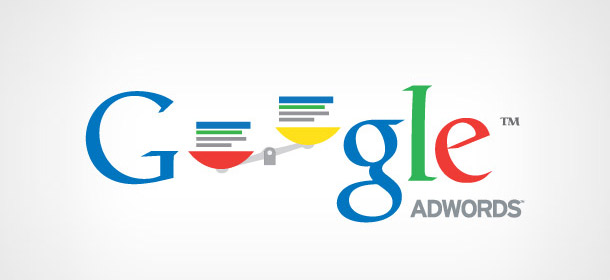
Most Brands Are Not Prepared to Manage Negative Social Comments
Over half of brands (55.5%) do not not have an effective strategy in place to deal with negative comments on social networks, according to a recent report from Social Media Marketing University (SMMU).
Some 24.5% of brands are in the process of developing a strategy for dealing with negative comments, 7.6% have strategies in place that are proving to be ineffective, and 23.4% do not have a strategy in place and do not have plans to develop one, the study found.
The report was based on data from a survey of 1,036 marketers, social media strategists, C-Level executives, and entrepreneurs.
Other key findings:
26.1% of respondents say their brand’s reputation has been tarnished as a result of negative social media posts, 15.2% have lost customers, and 11.4% have lost revenue.
58.2% of brands receive customer complaints via social media occasionally, 10.9% receive them somewhat often, and 4.9% receive them very often.
Only 17.6% of brands strive to respond to customer complaints on social media within an hour. Most (52.2%) respond within 24 hours, and 21.4% percent rarely or never respond.
About the research: The report was based on data from a survey of 1,036 marketers, social media strategists, C-Level executives, and entrepreneurs conducted February 10-13, 2014.
Source: https://www.marketingprofs.com/charts/2014/24698/most-brands-are-not-prepared-to-manage-negative-social-comments